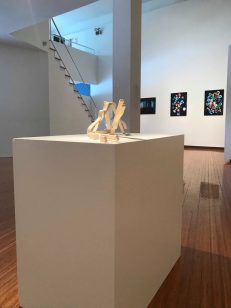The Prichard Art Gallery is showcasing the many talents of the University of Idaho College of Art and Architecture (CAA) faculty in various multimedia exhibits until April 6.
Roger Rowley, director of the Prichard Art Gallery, said he has curated this specific exhibit for so long he can’t even remember the first year that he did it. But each year he tries to showcase the faculty’s talents in an interesting way.
“Every year, I pitch to the faculty that it’s not just an art exhibit, it’s open to all and all their research,” Rowley said. “Some faculty’s work is more intellectual that can’t be displayed, so it’s understood that not all faculty is going to participate, but we try to emphasize the fact that it’s meant to show what the faculty in the college does and all the areas of research.”

Nicole Hindberg | Argonaut
The Prichard Art Gallery is showcasing the works of the UI College of Art and Architecture faculty members until April 6.
The exhibit, which will become a biannual event, began with a reception. Rowley said more than 200 people attended, providing a glimpse of the support the community has for this specific exhibit and the faculty involved.
“There’s not just current faculty members, there are people who are hired as temporary lecturers and we also have retired professors. We are trying to keep the continuity in time in order to keep the history alive. It also keeps them connected and shows where we were to where we are now,” Rowley said.
There are many mediums within the exhibit, with each showcasing the talents and research of the CAA faculty members participating.
For example, one piece showcases David Griffith’s research as a social-ecological scientist digitally.
“I’m interested in intersections and interactions in and between systems, whether that be among fungi and plants, insects and plants, or humans and the fungi and plants we forget surround us constantly,” said Griffith.
There are also artists who focus on topics considered to be generally overlooked, such as Mike Sonnichsen’s work centering on plastic use.
“One aspect of my work is to redirect attention to the overlooked plastic items from our domestic sphere. Utilizing this subject matter, I am torn because while I am mining what I consider interesting items — plastic drinking straws (and) laundry detergent caps — for their beautiful and hidden design aspects, I am also aware of their unsustainable impact on the environment. I think the dazzling colors and forms may lure a viewer to study the images, but what any viewer takes away from the work ultimately reveals more about their own relationship with our present consumer society,” Sonnichsen said.
Other faculty members, such as Randall Teal, use their knowledge from their research to create stunning photographs.
“This off-the-grid cabin in the St. Joe National Forest of northern Idaho was conceived as three living spaces connected to the surrounding forest through a singular architectural gesture,” said Teal of his photographs.
The connection between their work and the faculty’s art is not the only well-thought out connection within the gallery, Rowley said.
The layout of the exhibit connects the ideas and statements the art pieces make, beginning with art pieces that take everyday objects and transform them into something else.
One art piece in particular showcasing past and present connections is the piece created by Roberto Capecci and Raffealla Sini. These two bought the home designed by Ted Prichard, the person whom the art gallery is named after and the first professor of architecture at UI. Prichard operated the college and hired other faculty members.
“He was art and architecture for three decades. He created art and architecture at the University of Idaho,” Rowley said.
This art piece in particular showcases many of these people Prichard hired and their connections to each other. Cappecci and Sini connected each person with lines, mirroring the look of a criminal investigatory board.
“There’s a narrative sense to the way the exhibit is set up and how people experience it. It’s an intricate experience rather than just separated into the faculty, the lecturers, retired folks or whatever else,” Rowley said.
Nicole Hindberg can be reached at [email protected]
